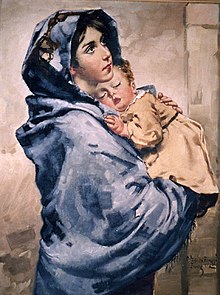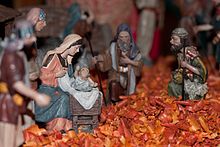Maria, ina ni Hesus
| Mary (Miriam) | |
|---|---|
 Madonna of the Streets ni Roberto Ferruzzi, c.1897. | |
| Kamundagan | September 8 (traditional; Nativity of Mary) c. 18 BC[1] |
| Dinakulaan | |
| Agom | Joseph |
| Mga aki | Jesus,[lower-alpha 1] possibly the brothers and sisters of Jesus. |
| Mga magurang | unknown; according to some apocryphal writings: Joachim and Anne[lower-alpha 2] |
Si Maria[lower-alpha 3] enot na siglo BC Galilean Jewish[2] babayi kan Nazareth, asin ina ni Hesus, base sa Bagong Tipan asin Koran.
An mga ebanghelyo ni Mateo asin Lukas sa Bagong Tipan asin Koran nilaladawan si Maria na birhen;[3] Base sa Kristiyanong Teolohiya naglihi siya kay Hesus sa paagi nin Banal na Espiritu mantang siya birhen. An milagrosong pagbados nangyari kan siya nagpakasal kay .[4] Inabanan niya si Joseph sa Bethlehem, na kung saen pinangaki niya si Hesus.[5]
An ebanghelyo ni Lukas nagpuon kan anunsyason nin buhay ni Maria, na kung saen si Gabriel na anghel nagpaheling saiya asin sinabi na siya an napili para magin ina ni Hesus. Base sa ebanghelyo kan pagdeklara nin pagkasanto,si Maria presente sa pagpako asin sinasabi na miyembro kan enot na mga Kristiyano sa Jerusalem. Base sa pagtukdo sa Katoliko asin Orthodox, an saiyang hawak digdi sa daga madiretso na sa Kalangitan; ini midbid na pagtubod sa Christian West bilang Assumption.[6][7]


The Virgin Mary holds a singularly exalted place in Islam and she is considered by the Qur'an to have been the greatest woman in the history of humankind. The Islamic scripture recounts the Divine Promise given to Mary as being: "Mary! God has chosen thee, and purified thee; He hath chosen thee above all the women of creation" (3:42).
- ↑ Undisputed according to the Bible and the Qur'an.
- ↑ The parents of Mary are unknown, but according to apocryphal gospels and some denominational traditions, it is Joachim and Anne. Some denomination traditions believe Heli and his wife to be the parents of Mary. Both are highly disputed. See Genealogy of Jesus § Explanations for divergence.
- ↑ (Lua error in Module:Lang at line 903: attempt to index local 'language_name' (a nil value).; Plantilya:Lang-arc; Hebrew: מִרְיָם, translit. Miriam; Plantilya:Lang-cop; Arabic: مريم, translit. Maryam), also known by various titles, styles and honorifics
Mga toltolan
[baguhon | baguhon an source]- ↑ Pevehouse, James (2010). Spiritual Truths (1st ed.). Pittsburgh: Dorrance Publishing Company. p. 110. ISBN 9781434903044.
- ↑ Raymond Edward Brown; Joseph A. Fitzmyer; Karl Paul Donfried (1978). "consonant+with" Mary in the New Testament. NJ: Paulist Press. p. 140. ISBN 9780809121687.
consonant with Mary's Jewish background
- ↑ (Lua error in Module:Lang at line 903: attempt to index local 'language_name' (a nil value).) Matthew 1:23 uses Greek parthénos virgin, whereas only the Hebrew of Isaiah 7:14, from which the New Testament ostensibly quotes, as Almah young maiden. See article on parthénos in Bauercc/(Arndt)/Gingrich/Danker, A Greek-English Lexicon of the New Testament and Other Early Christian Literature, Second Edition, University of Chicago Press, 1979, p. 627.
- ↑ Browning, W. R. F. A dictionary of the Bible. 2004 ISBN 0-19-860890-X page 246
- ↑ Ruiz, Jean-Pierre. "Between the Crèche and the Cross: Another Look at the Mother of Jesus in the New Testament". New Theology Review; Aug. 2010, Vol. 23, Issue 3, pp. 3–4
- ↑ Munificentissimus Deus: Dogma of the Assumption by Pius XII, 1950, 17
- ↑ Holweck, Frederick (1907), The Feast of the Assumption,(The Catholic Encyclopedia), 2, New York: Robert Appleton Company, access date April 18, 2015
